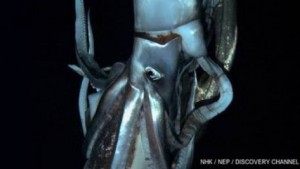A screen grab from the team’s cameras of a vibrant giant squid in its natural habitat. (PHOTO: NHK/NEP/Discovery Channel)

An ocean-going SWAT team of oceanic brainpower and technological brawn says it has captured moving images of a marine monster in its lair. In a PSMag.com article last July we detailed what would be the successful attempt to capture the elusive Architeuthis dux, AKA the giant squid, on video. Writer Ben Hellwarth noted:
Architeuthis dux has mostly been seen dead or dying after washing up on shore, or when inadvertently caught up in commercial fishing nets. It has almost never been witnessed swimming freely, feeding, or otherwise going about its cephalopodic business in its natural environment. Consequently, far more is known about the behavior of a creature like, say, Kim Kardashian, than about the world’s largest [up to 45 feet long] invertebrate.
Since the squid tends to swim in the open ocean at depths starting at 400 feet deep, with plunges to a half mile, the animal’s privacy was pretty well kept – until now. A team from the Japan Agency for Marine-Earth Science and Technology, the Discovery Channel, and Japanese broadcaster NHK says it has cracked the kraken case by visiting the eight-armed beastie at home, and has the tape to prove it. (With two of the partners TV networks, you’ll have to wait until January 27 to see their evidence.)
The expedition focused on an area more than 500 miles south of Tokyo around the Ogasawara Islands, rightly believed to be a prime hangout for the squid; the sighting comes from the vicinity of Chichi-Jima, the largest island in the archipelago. (World War II buffs may recall the islands as the Bonins.) The team brought three submersibles with them, and those undersea craft made all the difference; Discovery says the mission saw more than 55 dives resulting in more than 285 hours searching and filming in the deep deep.
In addition to hardware, the team had some of the top squid researchers on the planet, including the wild Kiwi marine biologist Steve O’Shea, eminent zoologist Tsunemi Kobodera, and oceanographer Edie Widder, CEO and senior scientist at the Florida-based Ocean Research & Conservation Association. Kobodera waxed eloquent in talking to AFP about the discovery:
“It was shining and so beautiful. I was so thrilled when I saw it first hand, but I was confident we would because we rigorously researched the areas we might find it, based on past data.”
Kubodera said the creature had its two longest arms missing, and estimated it would have been eight metres long if it had been whole. He gave no explanation for its missing arms.



